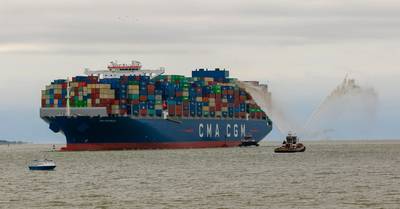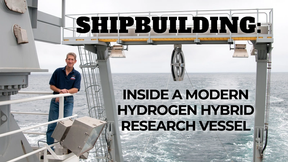Charleston Will be the Deepest Harbor on the US East Coast
This September, the U.S. Army Corps of Engineers, Charleston District awarded the final two dredging contracts on its harbor deepening project, which will make Charleston’s harbor the deepest on the East Coast.
The contract awards also coincided with the arrival September 20 of the CMA CGM Brazil, a 15,072-TEU containership stretching 1,200 feet long, and the largest containership to ever call on the East Coast and Charleston harbor.
Charleston was the last stop on its East Coast itinerary, because the harbor's depth permitted full loads before the ship made the return trip back to its home port in Shenzhen, China.
Located midway along South Carolina's Atlantic coastline, the Charleston Harbor also supports a vital defense mission and is one of the nation’s 17 strategic ports for national defense.
Valued at $597 million, the Charleston Harbor Deepening Project, known as Post 45, takes Charleston’s federal entrance channel to 54 feet, the lower harbor to 52 feet, and the upper harbor to 48 feet.
“The primary purpose of this project is to address transportation inefficiencies resulting from tide restrictions,” said Lt. Col. Rachel Honderd, district commander, at the SCPA’s press conference welcoming the large containership. “It’s to enable new Neo-Panamax vessels like the CMA CGM Brazil into the Charleston harbor.”
Post 45, which began as a feasibility study in 2010, kicked-off the project’s construction phase in early 2018. The four-year, five-contract deepening operation is projected to complete all dredging construction in 2022.
“Taking a project of this scale and impact from a feasibility study to completion in 12 years and within just six years of its federal construction authorization is a testament to the vision of the Port, the cooperation of local leaders and the determination and professionalism of the Charleston District and the Army Corps of Engineers,” Honderd said.
The short and long-term economic impacts of this project both locally and for the nation are far-reaching.
“The project has a benefit-to-cost ratio of 6.4,” said Honderd. “In other words, the project gives $6.40 to the state and national economies for every $1 invested.”
Officially awarded September 9, contract 4 deepens the portion of lower harbor connecting the Cooper River from the confluence with the Wando River to the South Carolina Port Authority’s new Hugh K. Leatherman, Sr. Terminal on the Cooper River to 52 feet. Contract 4 was awarded for approximately $53 million to Great Lakes Dredge & Dock Construction of Oak Brook, Ill.
Eight days later on September 17, Charleston District awarded the fifth and final deepening contract, for an estimated $32 million, to Marinex Construction, Inc. of Charleston. Contract 5 deepens the stretch of upper harbor from the new Hugh K. Leatherman, Sr. Terminal to the North Charleston Terminal to 48 feet.
Combined, these two contracts remove nearly 10 million cubic yards of material from the harbor floor.
Beyond the project’s projected completion in 2022, the project team will continue to focus on environmental monitoring and mitigation, accounting for and properly mitigating impacts to wetlands, historical resources and hardbottom habitat, said Jeremy Johnson, project manager, Post 45.
The Army Corps has maintained Charleston’s harbor for more than 140 years, dredging it every year since, to ensure the channel is at the required federal project depth.
“As we ring in our district’s 150th anniversary in South Carolina next year, we hope to continue the important work of maintaining Charleston’s harbor for the next 150 years,” Honderd said.














